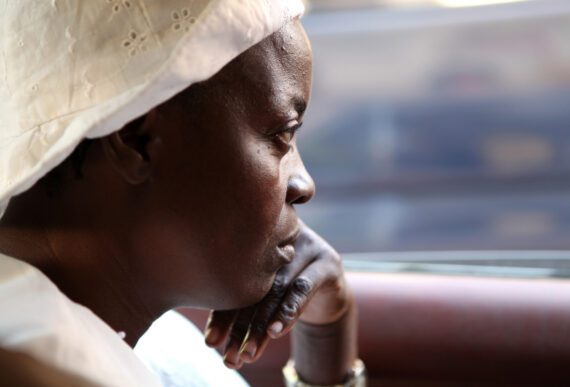In celebration of Earth Day on April 22, Bread for the World speaks with Karyn Bigelow, a research analyst with Bread for the World Institute, about the connection between hunger and climate change, especially during the coronavirus (COVID-19) pandemic.
Q. It’s hard not to acknowledge what is going on in the world today with the global coronavirus pandemic. One story focused on the fact that air pollution levels have dropped significantly around the world. Could there actually be a silver lining to the coronavirus? Are there lessons to be learned from this crisis as it relates to climate change?
A. I think it is too early to know the full lessons that will come out of this experience. However, we know that the planet is getting a much needed break from the damage and pollution that humans put on it daily. This could lead to long-term practices to be more environmentally friendly, such as having events using teleconference systems. My hope is that out of this unprecedented time we will learn from this experience and innovation will come to combat climate change in the coming months and years.
Q. Describe the connection between hunger and climate change? How do they affect each other?
A. Climate change and agriculture have a unique relationship to each other, which can heighten the levels of hunger around the world. Every area of our food system contributes greatly to the emissions of greenhouse gases.
On the other hand, climate change then impacts agriculture. The ability to grow food is highly dependent on the environment around it. Many places around the world are struggling with drought, extreme heat, and deep freezes. All of these things make it harder for farmers to grow large amounts of food. Limited food supplies can lead to increases in food prices, which can lead to hunger and malnutrition.
Also, when natural disasters happen, hunger is more likely to rise, especially for populations that are were already facing poverty. This is particularly true in international countries where there are no social protection programs, like Disaster SNAP, which helps people have access to food immediately after an emergency.
Q. You and your Bread colleague, Jordan Teague, are working on a healthy diets simulation. Explain what that is and how climate change affects the availability of food – especially in developing countries?
A. Jordan and I were inspired by the Racial Wealth Gap Simulation that our colleague, Marlysa Gamblin, developed a few years ago. The challenge allows people to learn and test their knowledge by creating meals that are both nutritious and good for the planet.
The trick is that people have to try to make those meals based on one of the multiple identities and budgets we created. For example, one participant could be a smallholder farmer in Guatemala, while another may be a SNAP recipient in the United States. Participants will see the challenges that many face to eat healthy when living in a low-income household and see how climate shocks, like extreme heat, can contribute to hunger.
Climate change impacts the availability of food in a number of ways. Climate extremes, such as scorching heat, drought, heavy rainfall, and deep freezes, highly impact a farmer’s ability to grow foods. For example, Nepalese farmers have struggled for a decade to grow food. Over the years, farmers have struggled with rice production because summer monsoons have become less predictable. Summer monsoons usually bring heavy rainfall to the region that brings the water needed for irrigation (important to produce rice and tea) and refilling water supplies for the year.
A lack of proper rainfall can be devastating to the country since 65 percent of the population works in agriculture and half of the farmable land is used for rice production. Although every region of the world has different challenges, farmers around the world are struggling because weather patterns have been changing for decades. At times this has caused shortages of crops and rises in food prices.
Q. How are countries doing toward meeting their climate goals? What does the research tell us? Are some countries doing better than others and why?
A. In 2015, two important moments happened for the world to work collaborate to address climate change. Countries, including the U.S., committed to the Sustainable Development Goals (SDGs) and initial Paris Agreement meetings were held. Over 180 countries signed the Paris Agreement—the U.S. has since announced withdrawal from the Agreement. Sadly, almost all nations are failing to be on track to meet the goals of the Paris Agreement and the SDGs.
Currently, only Morocco is doing well to meet the progress of the agreement. They are on track to meet their commitment to change 52 percent of their electricity to renewable energy by 2030. India, Costa Rica, Philippines, Ethiopia, Kenya, and Bhutan are making progress, but not enough to meet the goals of the Paris Agreement.
Unfortunately, the United States is considered to be critically insufficient in our efforts to combat climate change. We have not taken enough action to reduce our emissions of greenhouse gases and continue to be one of the biggest emitter countries in the world.
Q. What are the ramifications to the world if countries don’t change course in how they address climate change?
A. Around the world people are currently feeling the impact of climate change. However, without drastic action by governments, catastrophe can happen. Millions of people will be forced to migrate, because some regions will be unlivable. Some countries so hot that people will no longer be able to live there, some coastal areas will be under water, and some places will be unable to grow food altogether.
For all these reasons and more, hunger and malnutrition will increase. By 2030, around 100 million people will be forced back to poverty, and consequently hunger, due to the instability that climate change causes.



